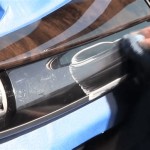The Best Cleaner For Car Interior Plastic Trim: A Comprehensive Guide
Maintaining the interior of a vehicle, particularly the plastic trim, requires careful consideration. Over time, plastic trim can accumulate dust, grime, fingerprints, and even suffer from sun damage, leading to fading and discoloration. Selecting the appropriate cleaner is crucial not only for aesthetic purposes but also for preserving the integrity of the plastic material itself. This article provides a comprehensive analysis of factors to consider when choosing the best cleaner for car interior plastic trim, examining different types of cleaners, application techniques, and preventative measures.
The interior plastic trim of a car encompasses various components, including the dashboard, door panels, center console, steering wheel trim, and other decorative elements. These surfaces are often exposed to direct sunlight, temperature fluctuations, and daily use, making them susceptible to wear and tear. Neglecting regular cleaning can lead to a buildup of dirt and grime, which can embed itself into the plastic surface and become increasingly difficult to remove. Furthermore, exposure to prolonged UV radiation can cause the plastic to become brittle, fade, and even crack over time.
Therefore, selecting a cleaner specifically formulated for automotive plastic trim is essential. Household cleaners often contain harsh chemicals that can damage or discolor the plastic. The ideal cleaner should effectively remove dirt and grime without leaving behind a greasy residue or causing any harm to the surface. It should also offer UV protection to help prevent future fading and cracking.
Understanding the Types of Cleaners Available
The market offers a diverse range of cleaners designed for car interior plastic trim, each with its own set of advantages and disadvantages. Categorizing these cleaners based on their composition and intended use can aid in making an informed decision.
All-purpose cleaners are a common choice for general cleaning tasks. These cleaners are typically water-based and contain a blend of surfactants and solvents to dissolve dirt and grime. While they can be effective for removing light surface dirt, they may not be strong enough to tackle stubborn stains or deeply embedded grime on plastic trim. Additionally, some all-purpose cleaners can leave behind a residue that attracts dust, requiring frequent re-cleaning.
Detailing sprays, often marketed as interior detailers, are specifically formulated for automotive interiors. These sprays typically contain a combination of cleaning agents, protectants, and UV inhibitors. They are designed to remove dirt and grime while leaving behind a clean, non-greasy finish. Detailing sprays are generally safe for use on various interior surfaces, including plastic, vinyl, and leather. However, it is important to choose a product that is specifically designed for plastic trim, as some detailing sprays may contain ingredients that can damage or discolor certain types of plastic.
Plastic-specific cleaners are designed specifically for cleaning and protecting plastic surfaces. These cleaners often contain specialized ingredients that help to restore the natural luster of the plastic while providing a protective layer against UV damage and future staining. Plastic-specific cleaners are typically more expensive than all-purpose cleaners or detailing sprays, but they can offer superior results and long-term protection for car interior plastic trim.
Wipes designed for car interior cleaning offer a convenient and easy-to-use option for quick cleanups. These wipes are pre-moistened with a cleaning solution and can be used to remove dirt, dust, and fingerprints from plastic trim. While wipes are convenient, they may not be as effective as spray cleaners for removing stubborn stains or deeply embedded grime. Additionally, some wipes can leave behind a residue that attracts dust or can dry out quickly, requiring multiple wipes to clean a larger area.
Key Considerations When Choosing a Cleaner
Several factors should be taken into account when selecting the best cleaner for car interior plastic trim. These factors include the type of plastic, the severity of the dirt and grime, the desired finish, and the presence of any existing damage.
Identifying the type of plastic is crucial because different types of plastic react differently to various cleaning agents. Some plastics are more sensitive to harsh chemicals than others, and using the wrong cleaner can cause discoloration, cracking, or other damage. To determine the type of plastic, consult the vehicle's owner's manual or the manufacturer's website. If the type of plastic is unknown, it is always best to test the cleaner on an inconspicuous area first to ensure that it does not cause any adverse reactions.
The severity of the dirt and grime will also influence the choice of cleaner. For light surface dirt and dust, an all-purpose cleaner or detailing spray may be sufficient. However, for stubborn stains or deeply embedded grime, a plastic-specific cleaner or a more aggressive cleaning solution may be necessary. In cases of severe grime buildup, it may be necessary to pre-treat the surface with a dedicated stain remover before using a cleaner.
The desired finish is another important consideration. Some cleaners leave behind a glossy finish, while others leave a matte finish. The choice of finish is largely a matter of personal preference. However, it is important to note that glossy finishes can sometimes attract more dust and fingerprints than matte finishes. If a matte finish is desired, choose a cleaner that is specifically designed to leave a non-glossy appearance.
The presence of any existing damage, such as scratches or fading, should also be taken into account. If the plastic trim is already damaged, it is important to use a cleaner that is gentle and non-abrasive. Avoid using cleaners that contain harsh chemicals or scrubbing agents, as these can further damage the plastic. In some cases, it may be necessary to repair or replace damaged plastic trim rather than simply cleaning it.
Proper Application Techniques for Cleaning Plastic Trim
The effectiveness of any cleaner depends not only on the product itself but also on the application technique. Following the recommended procedures can ensure optimal results and prevent any potential damage to the plastic trim.
Before applying any cleaner, it is important to prepare the surface by removing any loose debris, such as dust, dirt, or crumbs. This can be done using a vacuum cleaner with a soft brush attachment or a microfiber cloth. Removing loose debris will prevent it from being ground into the plastic surface during the cleaning process.
Spray the cleaner onto a microfiber cloth, rather than directly onto the plastic trim. Spraying directly onto the plastic can lead to oversaturation and streaking. Using a microfiber cloth will also help to prevent scratches and swirl marks. Ensure that the cloth is clean and free of any abrasive particles.
Gently wipe the plastic trim using a circular motion. Apply light pressure and avoid scrubbing aggressively, as this can damage the surface. Pay attention to areas that are particularly dirty or grimy. For tight spaces or intricate details, use a small brush or cotton swab to reach difficult-to-clean areas.
After cleaning, wipe the plastic trim with a clean, dry microfiber cloth to remove any excess cleaner and buff the surface to a shine. This will help to prevent streaking and leave behind a clean, non-greasy finish. For cleaners that contain UV protectants, allow the product to dry completely before exposing the plastic trim to direct sunlight.
Repeating the cleaning process regularly is essential to maintain the appearance of the plastic trim and prevent the buildup of dirt and grime. The frequency of cleaning will depend on the environment in which the vehicle is driven and the amount of use the interior receives. However, as a general rule, cleaning the plastic trim every few weeks is recommended.
By understanding the different types of cleaners available, considering the specific needs of the plastic trim, and following proper application techniques, vehicle owners can effectively clean and protect the interior plastic surfaces, preserving their appearance and extending their lifespan.

Best Interior Trim Cleaners 2024 Auto Express

How To Thoroughly Clean Plastic Surfaces Of Car Interior Detailing Like A Pro Series

Best Cleaner For Car Interior Plastic Results Mind Blown

How To Clean Interior Plastic Autobead

Best Car Interior Cleaners For 2024 Tested

Best Plastic Car Trim Rer 303 Protect Vs Mothers Turtle Wax Meguiars Cerakote

11 Best Car Interior Cleaner 2024 Autozone

Autocar Test What Is The Best Interior Trim Cleaner

Best Car Interior Cleaners Review 2024 Ratings

How To Clean Interior Plastic In Your Car Mobile Valet Neatandtidy Ie
Related Posts








